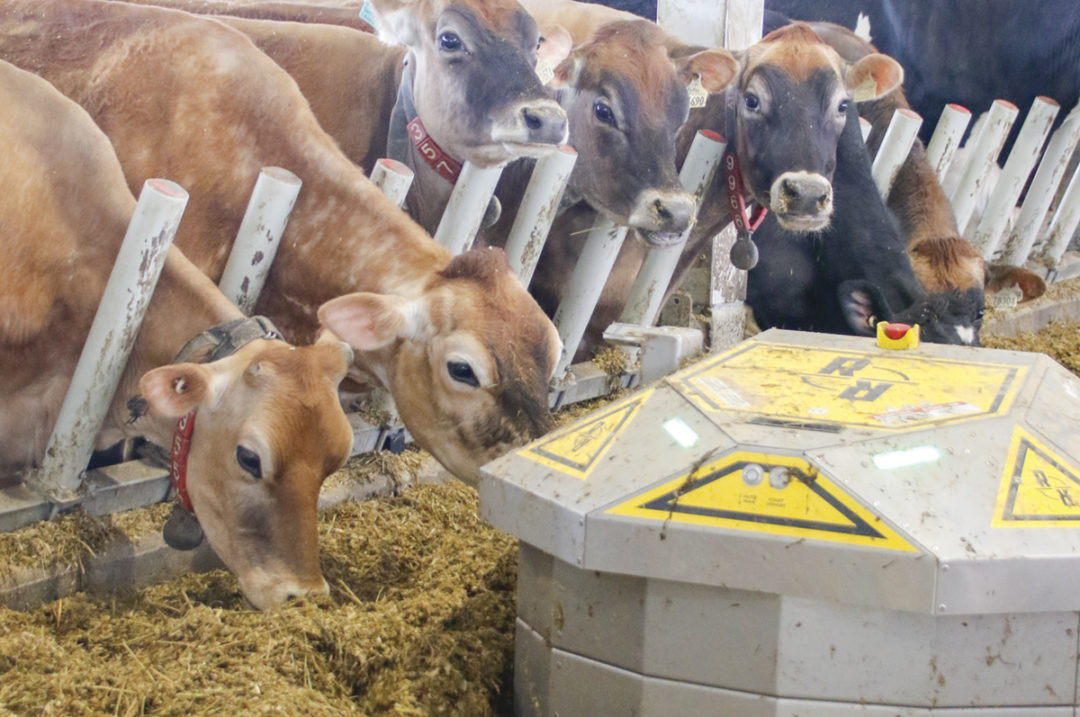Milkfat is an important component of dairy products, contributing to their flavour, texture and nutritional value. Milkfat is a key component of a dairy producer’s paycheque. Improving milkfat yield in dairy cows is crucial to maximize productivity and profitability for dairy farmers. Here are strategies and best practices to enhance milkfat production, ensuring high-quality milk and dairy products.
Nutrition strategies
Optimizing nutrition is one important way to help improve and maintain a high milkfat level. Balanced nutrition plays a vital role in milkfat synthesis, as it assures proper energy sources – a steady supply of precursors needed for the mammary gland to produce milkfat. Dairy cows require a well-formulated diet that meets their energy needs while maintaining an optimal balance of carbohydrates, proteins and fats.
Specifically, incorporating certain feed components can help promote milkfat production. Fibre-rich forages that include high-quality and highly digestible forages help support healthy and efficient rumen activity, a vital aspect of milkfat precursor formation. High-quality forages supply the necessary fibre and carbohydrates needed for rumen fermentation, driving milkfat production.
Consistent energy intake is helped by providing a steady supply of energy-rich feeds, such as grains and oilseeds, to meet the energy requirements of dairy cows but also to provide a key energy supply for de novo lipid synthesis.
A third strategy that has developed significantly over the past several years is fatty acid supplementation. Certain fatty acids, such as rumen-protected fats or oils rich in unsaturated fats, can improve milkfat content. Continuing research is focused on determining the optimal fatty acid profile needed to improve milkfat synthesis without causing milkfat depression with the use of specific unsaturated fatty acids.
Specific fatty acids such as palmitic or oleic acid have been shown to act both as a precursor of de novo fatty acids and as a signaling molecule, which triggers milkfat production by the mammary gland of dairy cows. These supplements influence the fatty acid profiles of the cow's milk and ultimately promote milkfat synthesis.
More tools are becoming available to better understand milkfat characterization and help develop nutritional strategies to influence milk component synthesis in dairy cows. A consultation with your nutritionist on how to best approach fatty acid supplementation for your herd may be an update that your herd needs.
Rumen health and digestion performance
Maintaining optimal rumen health is essential to support high milk component production in dairy cows. First, consistent feed rations are essential. Regularly monitor the consistency and quality of your dairy cows' feed ration to ensure it is balanced and meets their nutritional requirements, especially during the summer months.
You may recall your nutritionist explaining the importance of pushing up feed or recommending the use of automated feed-pushing devices to ensure consistent feed intake. Likewise, it is best to avoid sudden changes in the diet, as it can negatively affect rumen function and specifically affect milkfat yield.
Proper fibre digestion helps promote milkfat substrate production and energy supply for high-producing cows. Adequate intake of long-stemmed forages encourages rumen microbial activity and enhances milkfat synthesis. Rumen-enhancing products are available to help support proper fibre digestion and gut health in dairy cows. High-producing dairy cows that are challenged will not perform at their full potential.
Avoiding acidosis, a condition caused by an accumulation of acidic fermentation products in the rumen, is critical, as this can severely impact milkfat production. To prevent acidosis, maintain a consistent feeding schedule, avoid sudden changes in food quantity or quality, and control access and use of high-starch or high-sugar feeds. Although these components can help improve production, they need to be properly balanced to support high milk component production and maintain proper rumen health.
Genetics and breeding
Milkfat production can also be tied to genetics and breeding performances. Improving milkfat yield can be achieved through selective breeding and genetic selection of cows with superior milkfat attributes. This strategy should be a part of a long-term goal compared to the shorter-term impacts of changes in nutrition or management approach. Breed associations and genomic evaluation tools can assist in identifying genetically superior animals for milkfat production. Genetic evaluations using genomic tools to identify animals with desirable milkfat traits can provide great insight into how to improve herd milkfat production in the long term. Evaluate the breeding values for milkfat percentage, yield and overall milk composition to make informed breeding decisions. Selectively breeding cows with superior milkfat records and including them as potential donors for embryo transfer programs can also improve milkfat yield over successive generations.
Cow comfort and management
Ensuring optimal cow comfort and proper management practices are essential for maximizing milkfat production. The CowSignals approach has often been cited as an efficient method to ensure the optimal use and configuration of your barn design to support cow comfort and help improve production levels. Keep in mind the six-diamond approach of optimizing feed, water, light, air, rest and space to help improve milkfat production in dairy cows.
- Providing well-ventilated barns with adequate space for cows to rest with minimal overcrowding helps cows improve milk component synthesis.
- Having the ability to move and exhibit normal behaviours will improve overall cow comfort and productivity.
- During hot and/or humid months, proper ventilation supports maintaining cows' body temperature within a comfortable range, reducing stress and the negative impact of heat stress on milkfat synthesis.
- Maintaining a clean environment and optimal protocols to minimize the risk of mastitis and other infections helps dairy cows to maintain and even improve milk production. While cows facing an immune challenge will never perform at their best potential, the provision of sufficient water and feed space across the barn will support milkfat production and promote overall cow health and milk quality.
- Minimize stress that can negatively impact milkfat production, such as abrupt changes in routine, overcrowding and excessive temperature changes during winter or summer.
These management best practices can help you maintain and improve high milk components production of your herd year-round.
Enhancing milkfat yield in dairy cows is crucial for dairy farmers to achieve optimal productivity and profitability. By optimizing nutrition, maintaining optimal rumen health, utilizing genetics and breeding strategies, and focusing on good cow comfort and management practices, producers can significantly improve milkfat production. Striving for consistent and high-quality milkfat content ensures the production of nutritious dairy products that meet consumers' preferences and expectations while increasing dairy producers' profitability.










